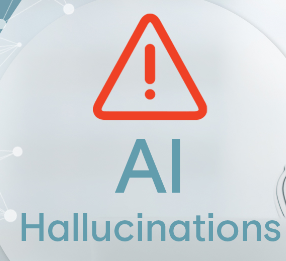Artificial Intelligence (AI) has become one of the most transformative technologies of the 21st century, powering applications such as virtual assistants, chatbots, self-driving cars, and image generators. However, despite their impressive abilities,
AI systems are not perfect. One of the most notable problems they face is known as AI hallucination which is a phenomenon in which an AI system produces false, misleading, or entirely fabricated information that appears believable.
Understanding what AI hallucinations are, what causes them, and how they can be reduced is essential for improving the reliability and trustworthiness of intelligent systems.
What Are AI Hallucinations?
AI hallucinations occur when an artificial intelligence model generates information that does not correspond to reality or its training data.
In other words, the AI “imagines” an answer that sounds correct but is factually wrong.
For example, a text-based AI might confidently claim that “Einstein won the Nobel Prize in Chemistry,” or an image generator might produce a person with six fingers. These are not intentional errors but they happen because the AI is designed to produce plausible responses rather than true ones.
AI hallucinations can appear in many forms, including false facts, fabricated citations, logical inconsistencies, or visually impossible images.
Causes of AI Hallucinations
The main cause of AI hallucinations lies in how these systems are built. Most modern AI models, such as ChatGPT or image generators like DALL·E, use deep learning architectures called neural networks. These networks are trained on vast amounts of data and learn to predict patterns rather than understand meaning.
Firstly, hallucinations arise because AI models are prediction engines, not reasoning systems. They generate text or images by predicting what is most likely to come next, based on statistical patterns from their training data. When the model encounters uncertainty or incomplete information, it may produce an answer that simply sounds right.
Secondly, imperfect and biased training data contribute to hallucinations. Since AI learns from human-created data found online, it inevitably absorbs misinformation, bias, and inconsistencies present in those sources. As a result, the AI can reproduce or even amplify errors that exist in its data.
Another important factor is the lack of grounding in real-world knowledge. Most AI systems do not have direct access to live data or sensory experience. They cannot verify facts or cross-check reality. They only rely on what they have previously learned. This limitation means an AI might confidently provide outdated or false information without realizing it is wrong.
Finally, AI models are designed to sound fluent and confident. This feature, while making interactions more natural, often leads to overconfidence , which means the AI delivers incorrect information persuasively, making hallucinations more difficult for users to detect.
How to Fix or Reduce AI Hallucinations
Researchers and developers are working actively to reduce AI hallucinations through several strategies.
One major approach is Retrieval-Augmented Generation (RAG). This technique allows the AI to search verified databases or the internet before producing a response, ensuring its answers are supported by real information rather than memory alone.
Another solution involves fact-checking and grounding mechanisms, where AI models are paired with tools that verify facts or compare their outputs against reliable sources. Similarly, Reinforcement Learning from Human Feedback (RLHF) helps AI models learn to admit uncertainty and avoid guessing when unsure.
Improving the quality and diversity of training data is also vital. By using curated, well-verified datasets, developers can reduce the likelihood of the AI learning false patterns.
Additionally, fine-tuning models for specific domains (such as medicine, law, or science) ensures that the AI’s knowledge in those areas is more accurate and reliable.
Conclusion
AI hallucinations represent a fundamental challenge in the development of intelligent systems.
They occur because AI models rely on statistical prediction rather than genuine understanding, often using imperfect data without real-world verification.
While hallucinations can undermine trust in AI, they are not an unsolvable problem.
Advances in retrieval systems, data quality, human feedback, and factual grounding are already helping reduce their frequency.
As AI continues to evolve, addressing hallucinations will be essential to creating systems that are not only intelligent but also accurate, transparent, and trustworthy.


Recent Comments